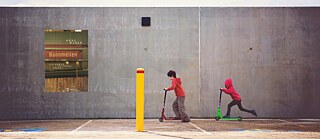Cherrypicker | Literature
On a foray through the suburbs

Anne Weber has lived in Paris for decades, but hardly knows the suburbs on her own doorstep. For her new book, she has therefore embarked on an unusual journey of discovery.
By Hendrik Nolde
More than 15 million people are expected to travel to Paris in the summer of 2024. They all want to visit the Summer Olympics - which could include a trip to the Seine-Saint-Denis department. In addition to the Paris-Charles de Gaulle international airport, the suburban area in the northeast of the French capital is also home to several competition venues, including the 80,000-seat national stadium, where the rugby and athletics competitions take place. However, very few of the sports-loving tourists will probably follow in Anne Weber's footsteps. The German author, who has lived in Paris for over 40 years, has forayed into the banlieues of her adopted hometown for her new book Bannmeilen (Ban Miles). She has paid particular attention to places that are otherwise rarely inviting to linger.
The starting point for these expeditions into the suburbs is a simple but pointed realisation that can be gained after just a short stay in Paris: Almost every time you set off somewhere here, you head towards the centre or at least within the (now invisible) city walls. Few paths, on the other hand, lead beyond the motorway ring road that separates the city centre from the sprawling suburbs that make up Grand Paris. Anne Weber wants to get to the bottom of this disparity. And so she follows in the footsteps of her old friend Thierry - a Frenchman with Algerian roots who grew up in the banlieue. The story accompanies the unlikely duo on seemingly endless walks along national roads, through gigantic high-rise housing estates and to cemeteries, where the noise of the neighbouring industrial areas means that there can hardly be any talk of peace and quiet. The supposed aim of these journeys of discovery is a film project by Thierry about the effects of the Olympic Games. However, this official motivation quickly fades into the background. Instead, the forays become an end in themselves, as the inhospitable destination develops a fascination for Weber and her companion that keeps them coming back.
Gallows humor instead of Kärcher rhetoric
The département, also known as Neuf Trois due to its postcode 93, officially has around 1.7 million inhabitants and is notorious as a social hotspot. It made international headlines in 2005 due to riots triggered by the death of two young people during a police checkpoint. The French president at the time, Nicolas Sarkozy, spoke of wanting to clean up the suburbs, which were among the strongholds of violent riots, with a pressure washer (he used the term Kärcher, the name of a well-known brand) . Anne Weber tries to counteract such blunt rhetoric and the stereotypes behind it with her story. Bannmeilen - which, incidentally, is the literal German translation of banlieues (inviolable precincts) - is the documentation of a search for traces of the actual living conditions behind the headlines. The author deliberately wants to shed light on the places that are always neglected in the discourse of those who usually move towards the centre: ‘The remote, forgotten corners are only forgotten by us, they are inhabited by others.’Anne Weber is always aware of her own privileged role as an observer. She repeatedly reflects on this in order to avoid a clichéd portrayal. She consciously does not want to engage in disaster tourism or fall into the trap of romanticising the conditions she finds. The last resort in the face of the sometimes terrifying reality are deliberately provocative, staged arguments with Thierry, which take aim at the extremes of social discussions and provide welcome comic relief with their gallows humour. Weber also repeatedly intersperses instructive historical observations, for example about the Algerian War and its post-colonial effects, which continue to shape contemporary French society.
The Olympics and the uncertain future
The development of Greater Paris is one of the most ambitious promises made by the organisers of the Summer Olympics. Sustainable positive effects are to be achieved in the Seine-Saint-Denis department in particular. The aim is to expand the transport network and renovate facilities for youth and popular sports. The Olympic Village on the Île Saint-Denis will also create 2,800 new homes, designed according to the latest climate-friendly building standards. Seventy per cent of these are to be used as social housing by the municipality after the end of the Games and provide relief for the notoriously overburdened property market in the greater Paris area. The concern that this will create gentrified islands that feel like foreign bodies in the urban chaos of the hyper-industrial non-places of the Neuf Trois is justified and has already led to protests. It is to be hoped that positive developments can nevertheless be recognised across the board in the future in France's poorest and, on average, youngest département. One thing is for sure: the material for a sequel lies on the streets of Seine-Saint-Denis, should Anne Weber decide to set off again in a few years' time on her expeditions for a sequel to Bannmeilen.Berlin: Matthes & Seitz, 2024. 301 p.
ISBN: 978-3-7518-0955-9
You can find this title in our eLibrary Onleihe.